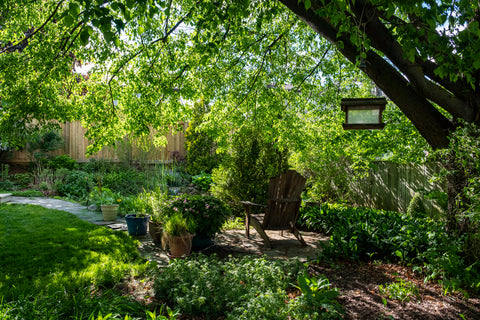Shade Gardening for Zone 5: How to Make the Most of Your Dark Corners
So, you’ve got that gloomy, north-facing side yard, or maybe a patch under that gorgeous but bossy maple tree that hogs all the sunlight. You’ve tried to grow grass there. It laughed and died. You tossed in a few sun-lovers and, well, they went to the big compost pile in the sky.
But don’t despair! That shady spot isn't a lost cause—it’s a golden opportunity for a shade garden. Let’s dig in (pun absolutely intended) to how you can turn those dark corners of your yard into leafy, lush sanctuaries in Zone 5.
What is Shade Gardening, Anyway?
Shade gardening is exactly what it sounds like—gardening in areas with limited sunlight. In Zone 5, where our growing season is already a bit shorter thanks to our frosty friends Jack and Jill Frost, managing light exposure is key.
Shade doesn’t mean gloom and doom. In fact, some plants prefer a break from full sun. Shade gardening allows us to harness those often-neglected spaces—along fences, under trees, beside buildings—and make them shine.
There are different types of shade, and knowing which one you’re working with is crucial to picking the right plants:
- Full shade: Less than 3 hours of direct sun a day.
- Partial shade: 3–6 hours of direct sun or dappled light.
- Dappled shade: Light filtered through trees.
- Dry shade: Often under trees or eaves where roots or structures suck up the moisture.
- Moist shade: Found near downspouts, low-lying areas, or where water naturally collects.

Best Shade-Loving Plants for Zone 5
Some plants live for the spotlight, and others are more like introverts who’d rather chill in the background. Here are some top performers for shade gardens in Zone 5, divided by plant type:
Perennials
These will come back year after year with very little fuss (just like that one friend who always brings dip to the party):
-
- Hosta: The queen of shade gardens. Comes in a zillion sizes, colours, and textures.
- Astilbe: Feathery plumes of pink, white, or red that bloom in summer. Loves moist shade.
- Bleeding Heart (Dicentra): Heart-shaped flowers on arching stems. Looks delicate, but it’s tough as nails.
- Brunnera (Siberian Bugloss): Think tiny forget-me-not flowers with heart-shaped leaves that are often silver-speckled.
- Solomon’s Seal: Elegant arching stems with little white bells—like a garden ballerina.
- Ligularia: Big bold leaves and tall yellow-orange blooms. Loves wet feet (moist shade, please).
Groundcovers
For the plant version of a cozy rug:
-
- Lily of the Valley: Spreads fast, smells heavenly. Prefers moist, well-drained soil.
- Sweet Woodruff: Starry leaves and tiny white flowers. Great under trees.
- Pachysandra: Evergreen, low-growing, and excellent for dry shade.
- Wild Ginger (Asarum canadense): Native to Ontario, with lovely heart-shaped leaves.
Shrubs
Want some structure? Shrubs to the rescue.
-
- Hydrangea (particularly Hydrangea arborescens like ‘Annabelle’): Performs well in part shade. Blooms like a champ.
- Japanese Kerria: Yellow pompom flowers in early spring, and green stems all winter.
- Dogwood (like Red-twig Dogwood): Colourful stems in winter, shade tolerant.
- Boxwood: Great for shady hedges and tidy structure. Slow-growing, but worth it.
- Rhododendron & Azalea: Acid-loving shrubs that bloom dramatically in part shade.
Design Tips to Brighten Shady Spots
Your shade garden doesn’t have to look like a sad corner of a haunted forest. With the right tricks, you can make it feel magical:
Layer It Up
Just like you’d layer clothes in a Canadian spring (parka in the morning, T-shirt by 2 PM), layer your plants. Start with groundcovers, mid-level perennials, and tall background shrubs for depth.
Play with Texture and Foliage
Shade plants often shine with interesting leaves instead of flowers. Mix big, bold hostas with airy ferns, or silver Brunnera with deep green hellebores. The contrast creates drama.
Brighten with White and Light Colours
White flowers and silver or variegated foliage pop in low light. Think of it like moonlight in plant form.
Use Hardscape for Highlights
Light-coloured stones, garden statues, or reflective garden balls can literally brighten shady areas. Paths made of crushed gravel or pale flagstone add elegance.
Container Gardens Work in Shade, Too
Got a deeply shady spot? Plant up a container with hosta, heuchera, and trailing lamium. Instant portable beauty.

Mistakes to Avoid in a Shade Garden
Even the best gardeners make mistakes—just ask anyone who’s ever planted mint without a warning label. Here are a few common shade gardening oopsies:
Overwatering
Shade means slower evaporation. If the soil feels moist, skip the watering can. Constant sogginess = root rot.
Choosing the Wrong Plants
Just because it looks pretty doesn’t mean it’ll be happy in shade. Sun-lovers like lavender and echinacea will sulk and die. Always match the plant to the conditions.
Ignoring Dry Shade
That “shady spot under the tree” might also be bone dry. Those tree roots are competitive. Amend the soil with compost, mulch well, and choose drought-tolerant shade plants like epimedium, lamium, or certain hostas.
Neglecting Maintenance
Shade gardens can become jungles if you’re not careful. Slugs and snails love moist shade. Keep an eye out, mulch responsibly, and divide overgrown perennials every few years.
Dry Shade vs Moist Shade: Know Your Type
This is one of those gardening truths people often miss. Shade isn’t just about the sun—it’s about soil moisture, too.
- Dry shade is most common under established trees or eaves where little rain reaches. You need tough, drought-tolerant plants here—like epimedium, periwinkle (Vinca), or sedges.
- Moist shade is usually found where water collects, near downspouts, or naturally low-lying areas. Plants like ligularia, astilbe, and ferns will thank you for the sogginess.
Before planting, do a simple test: dig a small hole, fill it with water, and time how long it takes to drain. If it’s still there 30 minutes later, congrats, you’ve got moist shade. If it vanishes like your last paycheck, it’s dry shade.

Bonus: Shade Gardening Checklist for Zone 5
- Observe the amount of sun/shade in your garden throughout the day.
- Test your soil for moisture levels.
- Choose plants suited to your type of shade (dry or moist).
- Layer plants for texture and interest.
- Add bright foliage and hardscape elements.
- Don’t overwater.
- Keep an eye out for slugs and pests.
So there you have it, shade gardening isn’t just about making the most of a challenging space—it’s about embracing an entirely different kind of beauty. Lush foliage, layered textures, and subtle colour make shady gardens peaceful, cool retreats from summer’s heat.
Whether you’re tucking hostas under your maple tree, designing a fern-filled nook, or building a serene pathway of groundcovers and blooms, you don’t need full sun to have a full garden.
Need help transforming your shady corner? Drop by Georgina Garden Centre, give us a shout online, or check out our YouTube tutorials with the Garden Girl. We’ll help you turn your shade into showstopper territory—no sunburns required.
Happy gardening!




